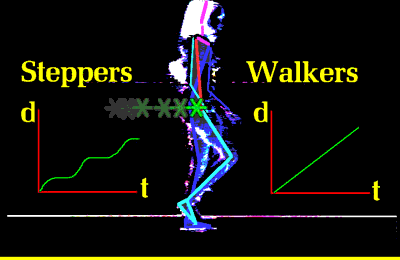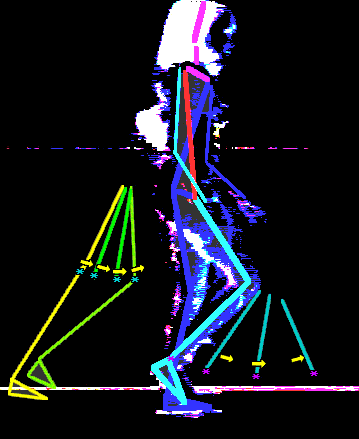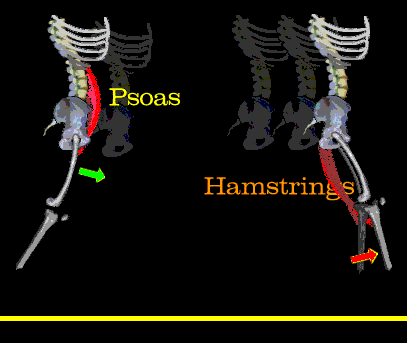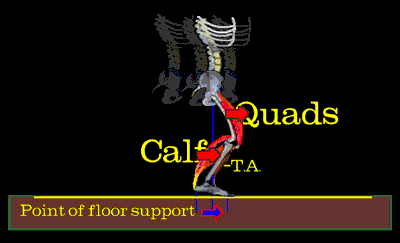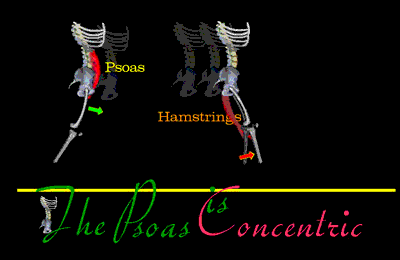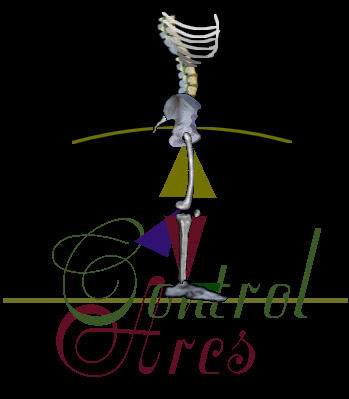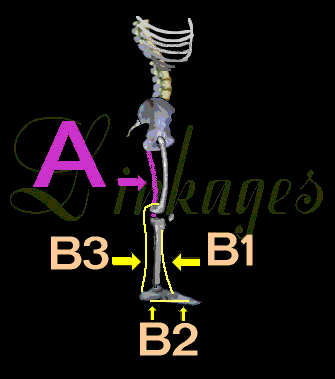 |
|||
|
Myobiology What was that about concentric, isometric and eccentric muscle activity??? And don't muscles contract to do what they do??? Consider this, if you were to gently put a very expensive, and somewhat heavy, vase on a very expensive polished table top - what muscle gets the big job? Right. The biceps. As you lower the vase the distance of hand from shoulder gets farther - the elbow is straightening, the biceps elongating. The biceps controls.. *************************
..the process by resisting gravity in a stepwise yield - a controlling strategy. The triceps also adds a bit of tone so as to add its sensibility (motion detection) to the process. Muscles can be sensory in function.
*************************
.. We must discuss control arcs, mechanical and sensory links, and..
*************************
..the role of eccentric muscle activity. I T'sal LaBo Utc Ont Ro L Three cases: In each case the muscle unit is stimulated so that a sodium potassium wave washes across the cell membrane with the sarcoplasmic reticulum dumping calcium ion which causes tropomyosin to roll over and unmask actin so that myosin can go nuts with ATP borrowed from fat via creatinine phosphate. But you knew that. First case (the logical one): Concentric Activity - the muscle unit, stimulated, contracts - shortens. This may be conceptually logical but it is wasteful. Inertia - the big MO - momentum - should always be considered as a better alternative. Push a bus or ride it? Concentric pushes. It costs the most fuel to undo when it is done. Second case (appealing to the couch potato): Isometric 'Activity'. Nothing moves? The activity is the chemistry! This strategy is needed to maintain a status quo, to keep something still, hold something back - whatever. Or it can be a spring board for the big MO to bounce off of, a steering mechanism utilizing the redirection of inertia. Stiffen one joint so that another joint has a better lever arm, or to move a rear rolling point to a forward one as the big MO takes whatever is there. This requires fuel but not as much as concentric activity. Third case (the improbable one): Eccentric Activity. The losing side in a tug of war, but the match was rigged, a fixed fight. The muscle elongates as myosin and actin disconnect moving the fibers in the wrong direction - can't you just see the myosin clawing at the actin slipping away with a deep cellular cry of 'Noooooooo". Oh. Uh.. mmm. me neither.. that'd be silly.. Anyway, this one uses the least energy of all. Ride the bus - the big MO. When humans walk, the energy usage is phenomenally low. We hear about how we are so inferior to the beasts of the earth in so many ways, eyes, hearing, sense of smell, sticky spit, everything - except our brains. Well if you follow the news, that brain claim is hard to argue with vigor. But we do excel at being very fuel efficient - better than just about anything - when walking - even on bumpy ground. Given that, you just know that eccentric use of muscle is the key. It isn't about movement - per se - it's ___ _____ _______. <= fill in the blanks.
Bottom line. Myobiology in humans is Physiology. The whole thing would make little sense pulled apart. It all works when in concert and in context. We can stroll and we can explode with speed and do so with little concern but great intuitive discernment of the surfaces we traverse. Some of those new jets have too many parts that need speedy subtle adjustments that no pilot could tend to. So computers get to manage the usual and speedy stuff. The pilot controls intent. Well, that's us. Most of the many many subtle and speedy things involved in walking get done by automatic circuitry. We just point the way and work the accelerator and brakes.
Let's revisit the stepper-walker distinction. If you graph forward distance traveled on the vertical axis and mark time on the horizontal axis, then steppers will graph out steps in their forward progression. Stoppages of distance traveled means decelerations. Stop-go -stop-go... We are talking about the travel of the BODY, in this context.
In short, steppers have no sustained momentum. Absent that, they have no ability to ride the MO bus. So they push it. Steppers must use concentric muscle activity as there is nothing going anywhere to grab onto.
A good way to judge a stepper is hide the legs as you watch and follow the upper body for even forward movement. Absent any way to conserve energy they spend it. Absent good control mechanisms, they are apt to fall prey to gravity. Just standing still requires muscle output. As steppers come to a stop frequently, those stops need to be unlike typical walking postures as walking postures are not stable. They don't work if still. They only exist as rides on momentum. Therefore, steppers, those who simply cannot do what is needed to utilize inertia as the key element in walking must have stability - places to recharge. That requires locked stable upright and even a wee bit of back knee stance posture.
But if momentum is to be the key ingredient to motion, then you can't stop it or you kill it. But you can deflect it, and get pulled by it. Eccentric muscle activity excels at this. But it needs a sensitivity to the forces of momentum and the ability to act smoothly and quickly. This bus doesn't stop for passengers. It's tough getting on.
Observe these elements: Swinging the thigh & swinging the shin. This is the double pendulum of the swing leg. The very first instance of thigh swing (drawn in yellow) gets a push - like a kid on a swing - actually a pull. The rest is free swing. As the knee travels forward it pulls the shin which swings past with zero muscular assist.
So, what happened? The psoas muscle which is attached to the spine and lies behind the intestines and kidneys pulls the top of the femur forward - BRIEFLY - initiating the forward thigh swing. As the foot is on the floor, the knee breaks into flexion and the heel rises as the toe persists temporarily on the floor. Then the toe also is pulled off and the shin swings forward. About 1/60th of a second (a jiffy) before the heel touches down and a smidge before the knee is fully straight and the thigh reaches its trajectory end, the hamstrings - BRIEFLY - activate. This hamstring activity decelerates the the shin and the thigh. Imagine what happens if you throw a bowling ball very hard and that ball has a wire which is tied to your belt. When the bowling ball reaches the end of the wire - you get yanked. That is exactly what the hamstring does. It tethers the swinging leg before its arc peaks and get the pelvis pulled forward. That transfers the leg swing energy to the body mass providing body momentum. That momentum comes just in time to ride the opposite leg in stance. The momentum is forward deflected by the stance leg.
The body travels forward of that momentum as the stance leg folds into measured flexion, kept from a full crumble by the quadriceps - until the body is just above the floor support point. That point began at the heel when the heel set down. But as the shin tilted forward - as the knee was bending - just when the knee is forward the ankle - the shin about 10o forward tilted, the whole ankle freezes solid. The calf muscles fire just as the shin passes vertical to slightly forward tilted. This ankle freeze causes the toe area to bear down as the heel rises off the floor. The knee begins to straighten as the body passes the floor support point. The stance leg nicely deflected potentially downward momentum forward by steering below it - cushioning as it came in and guiding it forward as it passes. When the leg swings, the foot is maintained in the tilted (up) posture and not allowed to dangle as the swing proceeds (by the T.A. muscle). [no - not tonsils and adenoids - tibialis anterior] The muscles?
The Psoas muscle, a muscle deep in the torso is the single muscle to act concentrically. It is a big body heat generating (nothing wasted) highly vascularized muscle. The hamstrings - which are said to be hip extensors and knee flexors -are active to slow hip flexion and knee extension. Eccentric. The quadriceps was active when the knee was flexing - eccentric. The calf muscle was active as the foot and shin angle got smaller - not during any downward push of the foot (which does not occur). Eccentric. The tibialis anterior muscle isometrically holds the foot posture through swing.
To control all this there has to be monitoring and ability to react in a measured and anticipatory way. The degree to which reaction is possible sets out limited arcs of potential effective control. Beyond these intent and action diverge. An important strategy in rehabilitation is pointing the control arcs in the direction of function. A child creeping on the floor may have wonderful knee control at 90o flexion, but no knee control in upright stance. Getting hip & knee & ankle control arcs in alignment with just sufficient range for realistic self control is what rehabilitative efforts are about - not range of motion per se. There is more on control arcs in the anatomy section. We must recognize that there are back up muscle actions that are available when power or extra speed are required. They may well serve for rehab substitution.
The shin bone is called the tibia. Anterior to (in front of ) the tibia is a muscle called the "anterior to the tibia muscle". Really. That's its name - in Latin - Tibialis Anterior, here labeled as B1. The A label points to the hamstrings which can flex the knee (if the foot is free - not planted). Right there is another substitution possibility. If the foot IS planted, the that same hamstring would extend the knee. Anyway - if free - it flexes the knee - concentrically. The TA muscle is a foot puller upper. But if it pulls the foot all the way up so as to fix it still and give the heel a near straight line with the tibia, then the calf muscle (B2) fixed at its distal end and attached above the knee will flex the knee. The forces are distributed through the long foot ligaments (B2). This is why adding too much weight to the hamstring exercise machine will give you plantar fasciitis (hurty B2). A detailed account of this is in the linkage section. That's a muscle linkage. But it is also a control link as the B1 B2 B3 structures share in the sensory experience of knee flexion. We can take advantage of this. We can also screw it up when we control things too stiffly . In the section dealing with muscle transfers - a video shows how this was used to create knee extension and knee flexion and hip extension while maintaining the sensory motion detection linkages. Above, the discussion showed one muscle per function. In fact, most of the muscles have several parts each. They differ in the way they attach and thus have differing velocity characteristics. Those differences may also be exploited when velocity driven defects inflict disability There is a subsection on linkages in the CP section.
|
| [P.O. Home] [Topics] [Muscle] [Basic Science] [Myobiology] |
|
|
|
|
